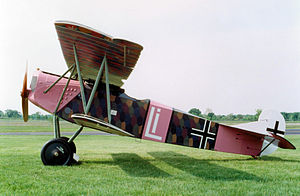Fokker D.VII
| Fokker D.VII | |
|---|---|
 |
|
| Fokker D.VII reproduction at the NMUSAF. The aircraft is painted in the colors of Leutnant Rudolf Stark of Jasta 35b | |
| Role | Fighter |
| Manufacturer | Fokker-Flugzeugwerke |
| Designer | Reinhold Platz |
| First flight | January 1918 |
| Primary user | Luftstreitkräfte |
| Number built | approximately 3,300 |
The Fokker D.VII was a German World War I fighter aircraft designed by Reinhold Platz of the Fokker-Flugzeugwerke. Germany produced around 3,300 D.VII aircraft in the second half of 1918. In service with the Luftstreitkräfte, the D.VII quickly proved itself to be a formidable aircraft. The Armistice ending the war specifically required Germany to surrender all D.VIIs to the Allies. Surviving aircraft saw continued widespread service with many other countries in the years after World War I.
Fokker's chief designer, Reinhold Platz, had been working on a series of experimental planes, the V-series, since 1916. These aircraft were characterized by the use of cantilever wings. Junkers had originated the idea in 1915 with the first all-metal aircraft, the Junkers J 1, nicknamed Blechesel ("Sheet Metal Donkey" or "Tin Donkey"). The resulting wings were thick, with a rounded leading edge. This gave greater lift and more docile stalling behavior than the thin wings commonly used at the time.
Late in 1917, Fokker built the experimental V 11 biplane, fitted with the standard Mercedes D.IIIa engine. In January 1918, Idflieg held a fighter competition at Adlershof. For the first time, frontline pilots would directly participate in the evaluation and selection of new fighters. Fokker submitted the V 11 along with several other prototypes. Manfred von Richthofen flew the V 11 and found it tricky, unpleasant, and directionally unstable in a dive. In response to these complaints, Reinhold Platz lengthened the rear fuselage by one structural bay, and added a triangular vertical fin in front of the rudder. Upon flying the modified V 11, Richthofen praised it as the best aircraft of the competition. It offered excellent performance from the outdated Mercedes engine, yet was safe and easy to fly. Richthofen's recommendation virtually decided the competition, but he was not alone in recommending it. Fokker immediately received a provisional order for 400 production aircraft, which were designated D.VII by Idflieg.
...
Wikipedia
